Like the Pendulum on a clock, the impeller acts like a weight at the end of the shaft and starts to wobble, or deflect. Any Corrosion, Erosion, or Cavitation increases the Pendulum Effect Problem! The motor bearings cannot hold the stresses that are set up by the Pendulum Effect and the Mechanical Seals, Sleeves, Bushings, Motor Bearings, and Motor fail prematurely. In extreme cases even the shaft can break.
Bearing and mechanical seal failures are directly proportional to the rotor weight, speed, the amplitude of the mechanical imbalance, as well as the radial loading on the shaft as a result of hydraulic imbalance. Cast impellers have several problems, which directly relate to premature bearing and seal failure:
1.) They are mechanically imbalanced as a result of the casting process and even after they are balanced, they become imbalanced as a result of wear, cavitation, corrosion and erosion.
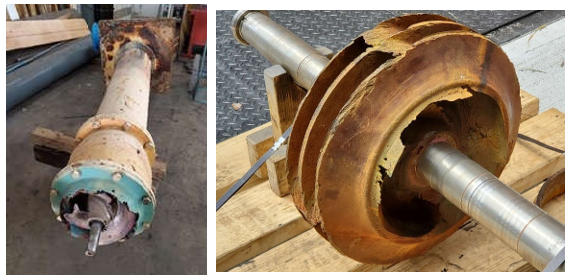
- This mechanical imbalance contributes to the “Pendulum Effect” which leads to premature bearing, seal, ring, and motor failure.
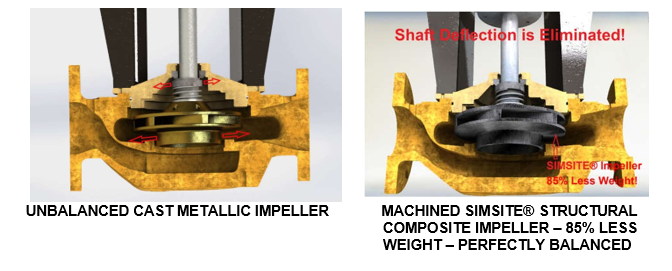
COMPOSITE IMPELLER – 85% LESS WEIGHT – PERFECTLY BALANCEDUNBALANCED CAST METALLIC IMPELLER MACHINED SIMSITE® STRUCTURAL
2.) Hydraulic Imbalance — Since castings are imperfect and the cooling of castings distorts the vane passages, the distortion of the exit ports causes uneven exit areas and flows, which creates shaft deflection every time a vane passes the cutwater. For example an impeller with 5 vanes operating at 1750 RPM – the vanes pass the cutwater 525,000 times in an hour period – that means the shaft is deflecting 12,600,000 times per day. If the same impeller is operating at 3600 RPM the shaft is deflecting 25,920,000 times per day!
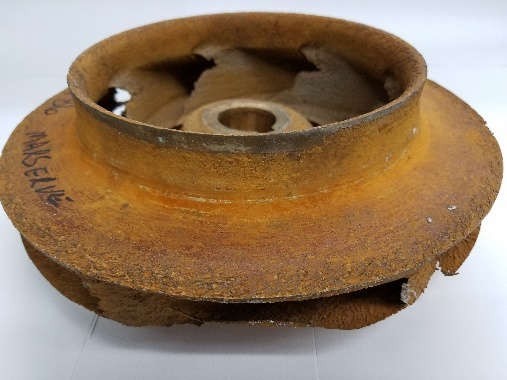
- This is why many companies have taken to condition monitoring of the bearings to predict the premature bearing failure. However, this is only putting a Band-Aid on the issue and is not addressing the real problem of premature bearing failure, which is the imbalance of the cast impellers!
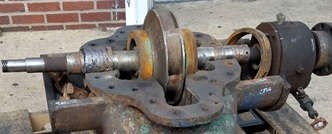
3.) Cast, or Molded impellers are not designed, or engineered for the “Specific Operating Conditions” of the pump in service. As a result, most pumps are not operating at the Best Efficiency Point (BEP) as a result they are operating away from the best efficiency point where radial loads are negligible. The farther away from BEP the higher the radial loads causing premature bearing, seal, ring, motor and even shaft failures!
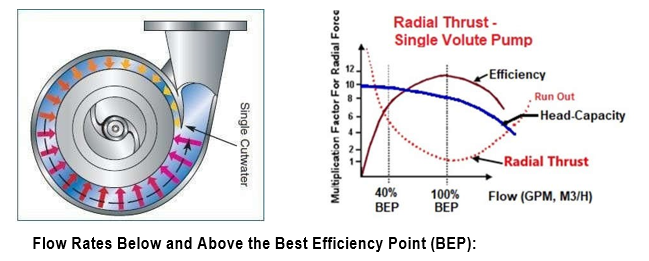
4.) Radial Load Imbalance — Fluid pressure surrounding the impeller at flow rates below and above the BEP are less balanced than at Best Efficiency Point (BEP). Unbalanced forces deflect the shaft in the direction of the red arrows, and vibration and shaft deflection increases due to unbalanced forces. As a result of the increase in radial loading, shaft deflection increases causing premature bearing, mechanical seal, casing ring and motor failures. Fluid flow efficiency also decreases.
Solution:
The solution is to use lighter weight, 100% machined Impellers and Casing Rings (non-cast, or molded, and machined from solid blocks of material) that do not corrode, or go into an imbalance such as SIMSITE® Structural Composite Impellers & Casing Rings.

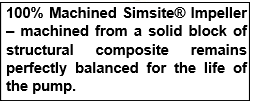
These machined structural composite Impellers are 85% less weight than bronze or stainless steel impellers and rings and do not go into an imbalance because the vane passageways and exit ports are all equally spaced as a result of being machined from one center position from solid blocks of the patented SIMSITE® structural composite.
100% Machined Simsite® Impeller – machined from a solid block of structural composite remains perfectly balanced for the life of the pump.
SIMSITE® Structural Composite Impellers are engineered and designed to operate at the Customer’s Operating Point (OP), making the Operating Point the Best Efficiency Point (BEP) Installing impellers that operate at the Best Efficiency Point is extremely important, because not only does it make the pump much more efficient, but it substantially reduces radial loads, shaft deflection, and eliminates hydraulic and mechanical imbalance! This allows the pump to operating substantially longer without premature failure of the bearings, rings, bushings, sleeves, mechanical seals, and motors.
Additionally, SIMSITE® Structural Composite Impellers and Casing Rings do not corrode in Seawater, River Water, Sewage, Wastewater, and Chlorinated Water and are excellent with most chemicals. Beyond never corroding in Seawater and other corrosive fluids, SIMSITE® Impellers, Pumps, and other Pump Upgrades operate at a much Higher Efficiency, and do not suffer from Performance Deterioration like metallic pumps, impellers, and pump parts.
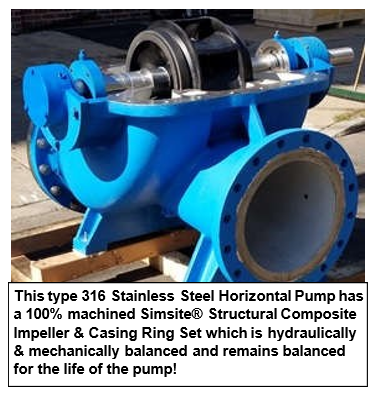
Corrosion, Cavitation, Erosion, and Performance Deterioration all substantially contribute to imbalance issues not only from a mechanical imbalance, but also from a hydraulic imbalance and from a radial loading imbalance.
It is crucial to eliminate Mechanical & Hydraulic Balance Problems, because they substantially shorten the life of the entire rotating element.Imbalance is the major cause of mechanical seal, bearing, bushing, casing ring, and motor failures!
